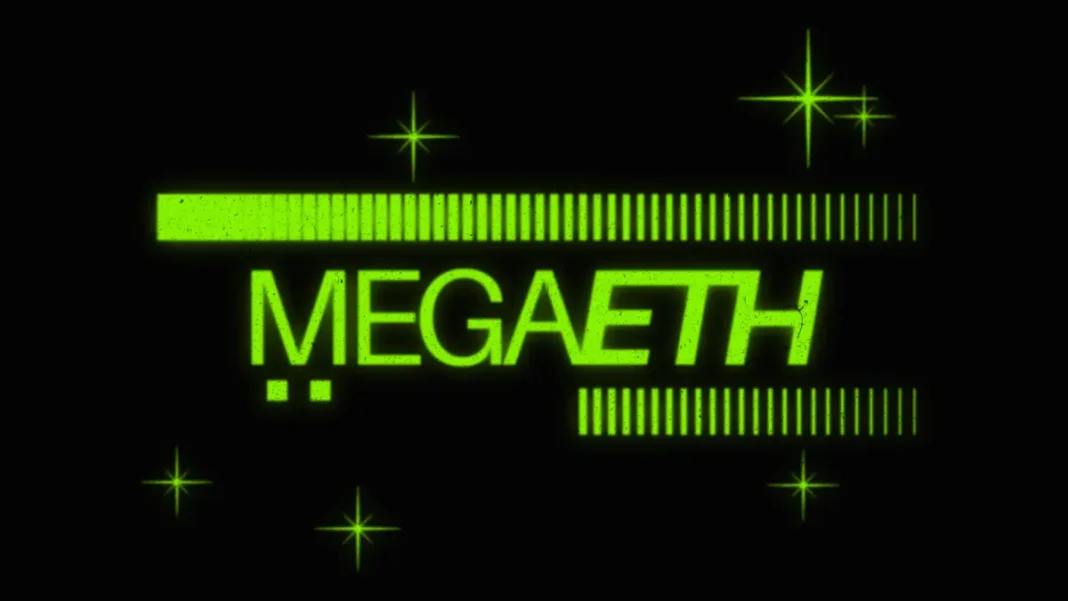Ethereum’s scaling and performance gap
Ethereum, the pioneer smart-contract blockchain, hosts thousands of projects, but continues to wrestle with fundamental bottlenecks: network congestion, elevated gas fees, slower block finality, and limited throughput. For Web2-style applications like high-frequency trading, gaming, real-time social dApps, and micropayments, such delays and costs are big deterrents.
Enter MegaETH: a new entrant promising Web2-level responsiveness inside the EVM ecosystem. According to its documentation, it supports 100,000 + transactions per second (TPS) and targets block times in the single-digit milliseconds (10 ms currently, with ambitions to go even faster). CoinGecko
What is MegaETH?
MegaETH, developed by MegaLabs, is an EVM-compatible blockchain architecture designed to scale Ethereum via extreme performance optimisation rather than incremental improvement. ICO Analytics Key highlights:
- Real-time/block-time targets of 1–10 ms. CoinGecko
- Throughput targets of 100,000+ TPS (and test benchmarks of far higher). GitHub
- Specialised node architecture: sequencers, provers, full nodes separated. alwin.io
- Full EVM compatibility, meaning existing smart contracts/tools should port. Gate.com
- Backed by notable figures/investors including Vitalik Buterin and Dragonfly Capital. CoinGecko
Is MegaETH an L2?
Yes – MegaETH is classified as a Layer 2 (L2) solution for Ethereum. The architecture anchors to Ethereum’s Layer 1 (L1) for security while providing high-throughput, low-latency execution at the L2 level. Messari
Who founded MegaETH?
The team behind MegaETH includes co-founders:
- Shuyao Kong (Co-Founder) – formerly business development at ConsenSys. ChainCatcher
- Yilong Li (Co-Founder) – a PhD in low-latency systems. ChainCatcher
- Lei Yang (Co-Founder & CTO) – a PhD from MIT researching decentralised systems. ChainCatcher
Team listings also include Namik Muduroglu among founding members. CryptoRank
Why MegaETH matters: benefits and expert insight
1. Near-instant finality & ultra-low latency
Imagine dApps where user interaction and blockchain response are almost indistinguishable. MegaETH’s architecture is designed to bring latencies down to 1–10 ms block times – a dramatic leap from typical L1s or many L2s. Messari
As co-founder Shuyao Kong says:
“The so-called Layer 2’s function is to scale… the users still felt gas and delay. We chose to solve today’s problem.” ChainCatcher
2. Massive throughput capacity
With targets of 100,000+ TPS and parallel execution engines, MegaETH enables use-cases that were previously infeasible on Ethereum – high-frequency trading, real-time gaming, micropayments at scale. alwin.io
3. Broad EVM-compatibility (developer-friendly)
Since MegaETH is compatible with the Ethereum Virtual Machine (EVM), developers can bring existing smart contracts, tools and infrastructure with minimal adjustments. That reduces friction, accelerates adoption. Gate.com
4. Backed by Ethereum’s security & ecosystem
By anchoring to Ethereum’s L1 security, MegaETH inherits a trusted settlement layer while delivering high-performance at L2. This dual approach offers a balance of speed + security. Messari
5. Ecosystem growth & momentum
MegaETH has already raised considerable funds (e.g., $20 M seed in June 2024 + $10 M Dec 2024) and gained investor backing. ICO Drops Moreover, testnet activity shows benchmarks such as 10 ms blocks and tens of thousands TPS. testnet.megaeth.com
Where MegaETH could make a difference
- DeFi & trading protocols where speed and throughput matter (e.g., arbitrage, derivatives)
- Gaming/metaverse/NFTs requiring real-time updates and responsiveness
- Micropayments/IoT where many small transactions demand minimal cost/latency
- Enterprise & global apps needing Web2-like UX but decentralised infrastructure
But… what about risks & caveats?
- Centralisation concerns: high-performance sequencer nodes require very powerful hardware (100+ cores, 1–4 TB RAM) which limits decentralisation. Messari
- Ecosystem maturity: as a newer project compared to mature L2s (e.g., Optimism, Arbitrum), MegaETH still needs to build developer adoption and real-world dApps. Messari
- Tokenomics/valuation unknowns: crypto markets are speculative and subject to macro/regulatory risk.
- Execution risk: Promises (100k+ TPS, 1 ms block times) are ambitious – delivering at scale remains to be seen.
Strategic Context & Comparative Insight
MegaETH vs Ethereum & existing L2s
According to comparative data (via Messari), MegaETH is designed to push beyond typical L2 limits:
- Target block time: 0.001 s (1 ms) vs Ethereum ~12 s. Messari
- Throughput: 10,000 mg/s vs Ethereum’s 1.25 mg/s. Messari
- Hardware requirements: MegaETH sequencer nodes demand ~100 CPU cores, 1–4 TB RAM, 10 Gbps bandwidth. Ethereum full node ~2 cores, 4–8 GB RAM, 25 Mbps. Messari
- Compared to L2 example: Optimism has block time ~2 s vs MegaETH’s ambitious ms range. Messari
Where MegaETH stands in the L2 race
- Many existing L2s (Optimism, Arbitrum, Base) focus on reducing fees and improving throughput over L1 – but still operate in seconds (not milliseconds) and with TPS in the tens of thousands, not hundreds of thousands.
- MegaETH aims to create a category of “real-time blockchain.” In that sense, it is less an incremental L2 and more a performance-leap L2.
- Its success will depend on ecosystem adoption: dApps that need real-time performance will validate MegaETH; if typical dApps are satisfied by current L2 speeds, MegaETH must carve out high-end niches.
What can you do now if you’re interested in MegaETH?
- Explore the megaeth explorer / megaeth scan: Check MegaETH testnet stats, transactions, dApps launched (via official website/testnet).
- Watch out for the megaeth mainnet launch: Mainnet is targeted Q4 2025 (according to Messari). Messari
- Monitor megaeth token / megaeth airdrop: While tokenomics are still emerging, MegaETH raised several rounds (seed, public sale) and an airdrop may be part of community-growth plans. ICO Drops
- Assess megaeth price movement & listings: Using platforms like megaeth coinmarketcap, CryptoRank, LiveCoinWatch, stay aware of listings and market sentiment. LiveCoinWatch
- Developers: consider building on MegaETH: If your dApp needs high throughput or low latency (gaming, real-time finance, IoT), testnet participation now might provide early mover advantage.
- Users: stay informed about fees, dApps, and migration: If you use Ethereum dApps, MegaETH could reduce costs and latency – look for bridges, supported apps, and ecosystem announcements.
Frequently Asked Questions (People Also Asked)
Q: What is MegaETH?
A: MegaETH is a high-performance, EVM-compatible Layer 2 blockchain built by MegaLabs, designed to deliver sub-second or millisecond transactions and throughput of 100,000+ TPS while leaning on Ethereum L1 security. CoinGecko
Q: Is MegaETH an L2?
Yes – MegaETH is a Layer 2 solution for Ethereum: it relies on Ethereum L1 for settlement/security but handles execution and throughput at its layer-2 stack. Messari
Q: Who is the founder of MegaETH?
MegaETH was co-founded by Shuyao Kong, Yilong Li, and Lei Yang, among others like Namik Muduroglu. ChainCatcher
Q: Will Ethereum hit $50,000?
While some bullish models propose ETH might reach $50,000 by around 2030 under favourable conditions (strong adoption, institutional flows), many analysts regard this as ambitious and note substantial obstacles. techfinancials.co.za
Q: What if you bought $1,000 of Ethereum 5 years ago?
Five years ago (mid-2020), Ethereum (ETH) was trading much lower (e.g., under ~$300 for much of 2020). A $1,000 investment then could have grown many-fold depending on timing and price swings, highlighting crypto’s volatility and long-term growth potential (but also risk).
Q: Is mainnet real money?
In blockchain parlance, “mainnet” means the production/live blockchain as opposed to testnet. Transactions on mainnet involve real value, real assets and are “real money” as opposed to test or simulation tokens.
Q: How much will 1 Ethereum be worth in 2030?
Forecasts vary widely — conservative projections suggest $20,000-$30,000, some bullish scenarios entertain $50,000+ depending on ecosystem growth. changelly.com
Q: Can I withdraw money from blockchain to my bank account?
Yes — many crypto platforms, exchanges, and fintech services allow you to convert crypto to fiat and withdraw to bank accounts. The process depends on regulatory regime, exchange policies, KYC/AML, fees, and bridge services.
Q: What about megaeth explorer, megaeth scan, megaeth faucet?
These refer to user-facing tools for MegaETH network:
- megaeth explorer / megaeth scan: Block explorers allowing you to view transactions, blocks, addresses on MegaETH.
- megaeth faucet: Often in testnet context, a faucet provides free test tokens so users/devs can try the network without spending real assets (e.g., MegaETH testnet).
“If you think of blockchain not just as slow, global settlement but as real-time infrastructure – MegaETH is targeting that shift. The question isn’t only ‘Can it scale?’ but ‘Can we make Web3 respond like Web2?’” – [Expert paraphrase]
In short: MegaETH stands out as a bold experiment in pushing the performance envelope of Ethereum Layer 2s. Its ambition – millisecond block times, hundreds of thousands TPS, full EVM compatibility – positions it as more than just “another L2,” but rather a leap-forward performance stack.
For technologists and businesses building latency-sensitive applications, MegaETH merits attention. For investors and users, it represents a speculative bet on next-gen infrastructure rather than mainstream adoption today.
Actionable take-aways:
- If you’re building dApps with high throughput or real-time requirements, evaluate MegaETH testnet and ecosystem now.
- If you’re following crypto investments, watch MegaETH’s token launch, listing, ecosystem rollout – but treat it with caution and proper risk management.
- If you’re a general user on Ethereum today, keep an eye on MegaETH as it could redirect traffic, dApps and value flows – but the majority of current activity remains on existing chains.
By tracking megaeth mainnet progress, exploring megaeth token developments, and reviewing megaeth explorer data as they emerge, you can position yourself ahead of the curve.


